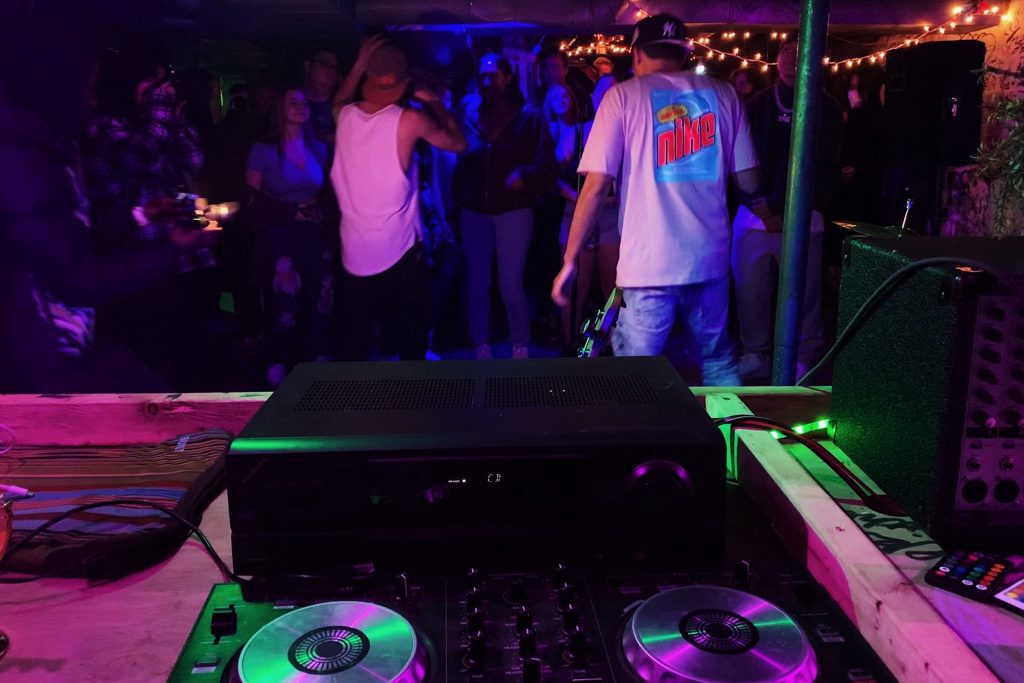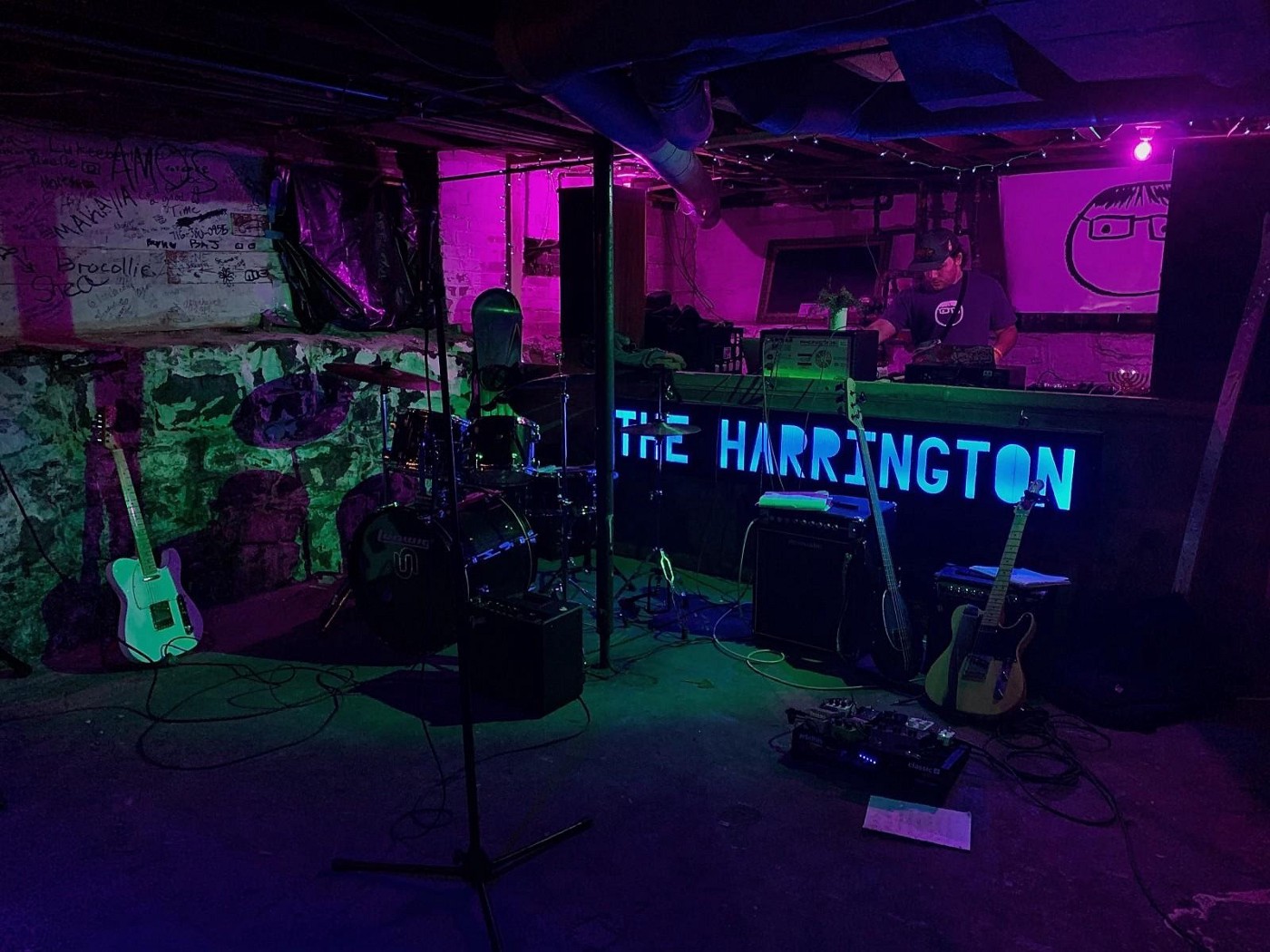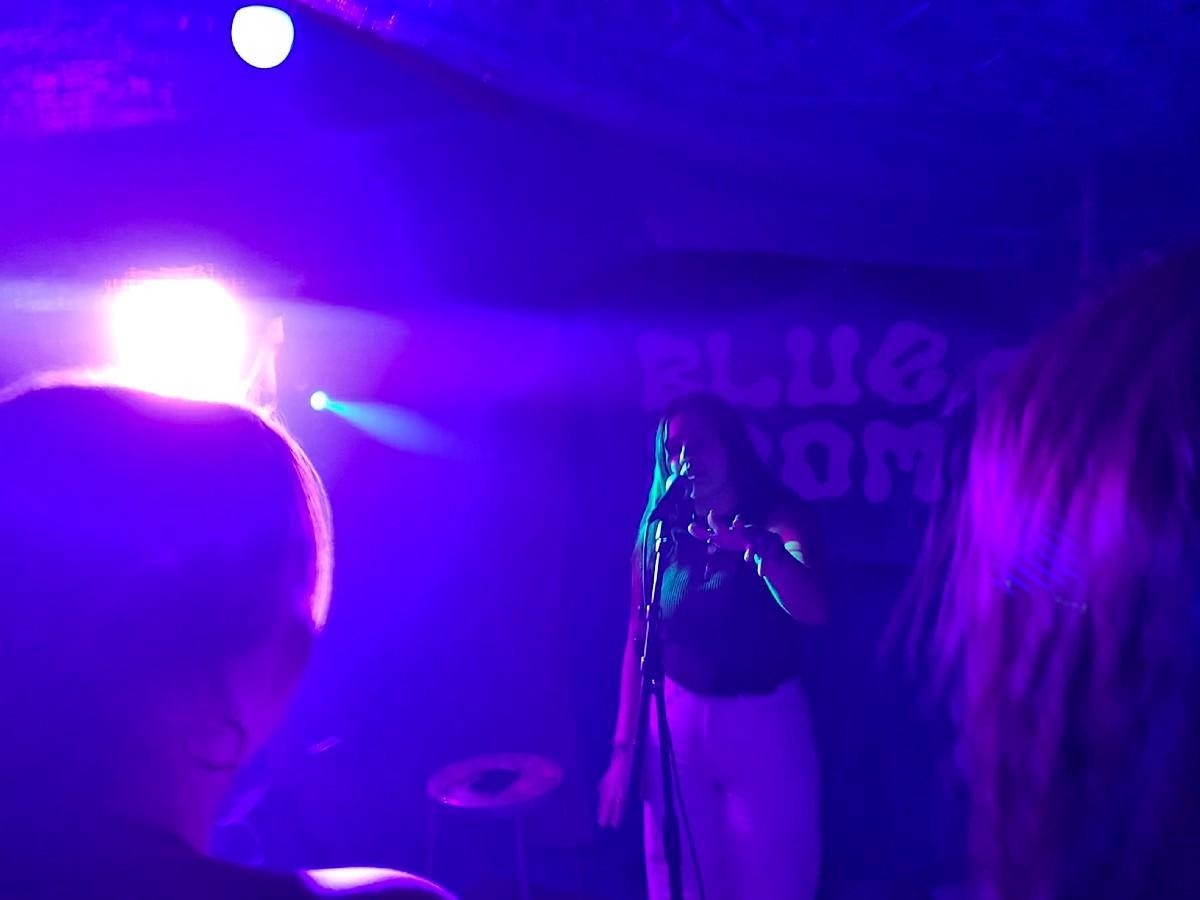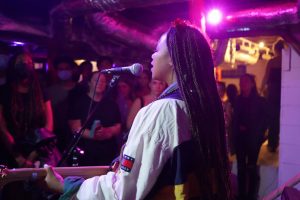The revitalization of Syracuse University’s underground music scene
The revitalization of SU’s underground music scene

A man sits alone on the side of a gray house, watching the dark street. It’s 11 p.m. on a Thursday, and students have already gone out for the night. Laughter cuts the silence when a group of 19-year-olds wanders down the sidewalk, heading to a party armed with vodka-filled water bottles. As they pass the gray house, they stop. A deep bass vibrates under their feet. They walk down the driveway toward the sound, and the man lets them inside. The sound travels up from the basement. The air becomes thick as they reach the base of the stairs. There’s a crowd, flashing lights, and, as they push toward the front, someone singing into a microphone.
DIY house shows pop up around most college campuses. They are essentially parties with live music, usually hosted in a basement and advertised through word of mouth. Some areas, like Boston, are nationally recognized for their student music scenes. Syracuse University doesn’t make those lists. But, as coronavirus cases dwindled on campus this semester, students threw multiple shows every weekend. The Summit, a group of DIY promoters, organized almost 40 shows in four months. Their Instagram saw a 400% increase in followers. Coming out of lockdown, students are looking for new weekend activities, and the promoters and artists create them.
Whitman School of Management senior Josh Feldman runs The Summit. A friend called him the “head honcho” of the SU scene. With his short brown hair under a green snapback and a silicone bracelet on his wrist, he looks more “frat” than “underground music.” He rushed his sophomore year but instead found his place with The Bedford, a DIY promoter group. He helped them organize a couple of house shows in 2019 and early 2020. By the time the pandemic slowed, The Bedford leaders had graduated. This semester, Feldman took over their organization with Buddy Murphy and renamed it The Summit. “I feel like I’m running a small company,” Feldman said. “Obviously, it’s not legit and highly illegal, but it’s definitely good fun.”
On Dec. 2, Feldman spent the day prepping for his second-to-last show of the semester at The Harrington. The Harrington is a regular gray house on the Eastside of Syracuse, rented by students who established their basement as a venue for live shows. Tonight, doors opened at 9:30 p.m. and music started half an hour after.

While The Summit mostly hosts shows with The Harrington, there are other houses on the Eastside that open their basements to local musicians, such as The Garden, The O, The Panic Room and The Coop. Another popular venue is The Blue Room, a basement covered floor-to-ceiling with blue plastic tarps. Most shows at The Blue Room are organized by Mosh Retirement, a one-man DIY promotion company run by Nicolas Misita.
Misita is in his sixth year at SU, finishing up his MBA. He started Mosh Retirement around four years ago after seeing underground shows at Space Camp, a student-run venue that hosted indie rock acts. The name is a term for the older metalheads who “retired” from the intense mosh pits of the hardcore punk scene, which Misita took an interest in as an undergraduate. But with what he called his long “hippie hair,” he felt out of place as an “indie-looking hipster kid” among metalheads. So, when his music taste expanded and he started the promotion company, he found the name fitting. Like Feldman, he also works with legitimate companies, like agencies and management companies that book tours and shows for bands. He saw how the pandemic disintegrated small, alternative bands in Syracuse.
“Artists didn’t really have the ability to keep things going to support themselves financially, so a lot of people just stopped. A lot of people got burnt out as well,” Misita said. “Before the pandemic, Syracuse definitely had a big jam band scene. There was a huge emo and shoegaze community here, as well. And the hardcore punk scene definitely had a thing. But once the pandemic started to feel a little bit more controlled, a lot of those scenes are no more.”
Misita and Feldman are trying to rebuild the SU scene. While Feldman focuses on booking student artists, Misita tries to hire a mix of regional and student performers. Mosh Retirement mostly hosts shoegaze, metal and punk artists, and The Summit consistently finds rap and indie artists. The result is a wide variety of crowds and genres every weekend on the Eastside.
By 9 p.m. at The Harrington, the three performing artists have sound-checked, and the staff has set up the merch stand and the food table, which offers mac and cheese and cake pops. The empty basement is decorated with string lights; purple, green, and blue light bulbs; and multi-colored disco lights. A backlit sign that reads “THE HARRINGTON” hangs on the DJ booth.
The SU music scene hasn’t always been sequestered to houses on the Eastside. David Rezak, a retired SU professor and creator of the Bandier Recording and Entertainment Industries program, remembers a dance hall behind the Orange Crate Brewing Company (also known as Lucy’s), where The Marshall apartment building now sits. Here, student artists played live shows for crowds of up to 300 people. Bands also performed at frat parties. Felix Cavaliere, a member of the Rock & Roll Hall of Fame band The Rascals, got his start in the 1960s with The Escorts in SU frat houses. At the same time, songwriter Lou Reed started his undergraduate career at SU. Rezak said he tried to join Cavaliere’s band — The Escorts were the biggest name on campus — but Cavaliere rejected him. So, Reed played house shows and frat parties with his own band, L.A. and the Eldorados. After graduation, he formed The Velvet Underground in New York City, another Rock & Roll Hall of Fame inductee.
Though SU has a history of producing great artists, the school itself keeps its distance from the music scene. Other than on-campus concerts arranged by University Union and the recording studio, SU Records, run by students and music professor Todd Herreman, the administration does not advertise or condone student-organized concerts. House shows are a liability. Underage drinking, fires, injuries and unhappy landlords all pose a threat to the university’s reputation. Still, Rezak understands why students are drawn to basement shows.
“The artists and the presenters and the fans all need to be as safety-conscious as they can in these venues that weren’t intended for mass gatherings,” Rezak said. “But besides the fact that, officially, [the university] had to not get involved with those things, they’re fantastic. It’s the irresistible force and spontaneity of great live music events in a very casual environment, and it makes opportunities for artists to make real money and real fans by close contact. And I think that’s really important.”
At 9:15 p.m., Feldman calls his staff to the second floor to pass out radios and earpieces. The artists lounge nearby on the couches in the greenroom, which is stocked with pizza and beer. After testing the radios, everyone disperses to their stations. A security guard sits outside at the side door and waits for the crowd. He has a list of 60 people who bought the $5 Venmo pre-sale tickets. Otherwise, it’s $7 at the door.
The tickets fund the whole operation. Feldman pays artists and staff members a portion of the door, and he tracks their profits on a spreadsheet on his phone. The amount of time Feldman and Misita put into each show varies by week, but between the planning, marketing and setup, a single show can be a 20 hour commitment. And with everyone’s compensation hanging on the numbers at the door, it’s hardly a stable income. “This is a hobby, essentially. I don’t make money from this,” Misita said. “If I do, it’s, like, enough to cover my gas bill and maybe get Chipotle a few times a week — if I’m lucky.”
Matt Lerro, The Summit’s sound tech, spent over $1,000 out-of-pocket on the speakers, chords, stands and interface that the team uses at every show. He sees it as an investment, though. Like Feldman and Misita, these shows are a means for him to gain experience and connections, as both a sound engineer and a rapper. He performs under the name Rro Da Ronin. You can tell he’s a rapper because he talks like he’s freestyling: loud and confident with changing flows. Though he has only performed at a couple house shows this semester, he hopes to grow in notoriety.
The Harrington fills within 45 minutes. Lerro stands at the DJ booth in a baggy black sweatshirt, where his 2013 MacBook is hooked up to the sound system. He’s playing the first rapper Swaggy J’s tracks and praying that his laptop doesn’t crash. It has before. But the music is blasting through the speakers, and the crowd moves to the bass. Swaggy J and his friend BJ, both SU students, jump around with their microphones and motion for the crowd to join them.
The attendees at basement shows are a mix of friends of the artists and promoters; students trying to get involved in the scene; and people who came across the Instagram promotions. It’s easy to tell them apart; the friends are the people singing along to original songs. But some student artists have made an impact beyond their friends and the SU campus, like the retro pop band NONEWFRIENDS., whose top song on Spotify has over 266,000 listens. Over 600 people RSVP’d to the band’s two-day Halloween concert. The pop punk group Picture Us Tiny, pop R&B artist ISHĒ and folk artist Sarah Gross also guarantee Feldman upwards of 150 students at the door.
Like the professional music industry, the underground scene is all about who you know. Having the “in” with top student artists can create your career. Junior film major Sedona Regan has been recording music since she started at SU, but she had no connection to other student musicians. When she randomly moved in with the lead singer of NONEWFRIENDS., Liz Stuart, she found herself opening for the band in an Eastside backyard in October. “I felt like I had literally no connection to the music world here, which felt super displacing and disorientating for me,” Regan said. “Then, you do one thing, and after that, you’re just doing it.” She booked The Blue Room in November with Mosh Retirement and hosted a release party for her album “Fishbowl” a week later.

Being in the music scene also means having access to “the calendar,” a shared spreadsheet that artists, venues and promoters use to schedule shows. When someone starts to plan an event, they put it in the calendar, so everyone else knows to not schedule their own show at the same time. For the most part, it prevents overlap and keeps competition out of the community. Artists and promoters go to each other’s shows, seeking new collaborations or just like-minded friends.
In the basement of The Harrington, the crowd waits for the next rapper to take the microphone. Feldman snakes through the crowd, making sure everything is running smoothly. Spencer Hillman stands near the wall waiting for the last performance, the singer Liv For Now.
Hillman is a member of the psychedelic rock band The Knu, which he created with two other SU students. Though one member has graduated, The Knu stayed together to perform in Syracuse. When the band first formed, it took time for them to get into the scene. “If you’re not in the music program, it’s pretty hard to let people know that you play music,” Hillman said. “And we kind of had to fight for attention at first.”
Now, they’re booking shows both on and off campus. They also created their own venue The Coop after building a wooden stage in their living room. “It’s been very gratifying to have the camaraderie with these people as fellow players,” Hillman said. “I’ve been a fan of watching them since sophomore year and endlessly telling them why I think they’re great. But now, we get a little bit of that love back when they hear us play.”
As the second rapper starts his performance, Hillman and Feldman talk on the side porch, taking a break from the humid basement. It’s 11 p.m. Other than a few sophomores who pre-gamed too long, the majority of the crowd is already inside. Feldman estimates it was somewhere between 150 and 250 people.
Feldman and Misita are already making plans for next semester, and artists are using the month-long break to write, practice and record. But, after the two promoters graduate in the spring, there’s no guarantee that The Summit and Mosh Retirement will continue without them. A house show scene based around students is constantly unstable. People graduate and leases expire. “Right now, it’s about trying to convince people, like, ‘Hey, if you like going to these shows, start a band, see what happens, make some noise,’” Misita said. “That’s a goal for me. How can I connect with kids and hopefully inspire them to start their own projects?”
Misita and Feldman revitalized an alternative space at a university known for its frat culture and parties. Feldman hopes that the underground music scene will continue to thrive because it is different from stumbling into a frat house. Both parties primarily take place in basements, but with the string lights and the set lists and the sanitized bathrooms, the house shows are a disparate environment.
“I want to give people an actual experience, as opposed to being pressed up against some person you don’t know, listening to house music,” Feldman said. “I want people to walk into the house and walk out and actually feel fulfilled and happy about what they did. We just try to create that environment so that people can actually feel comfortable with who they are and express themselves.”







